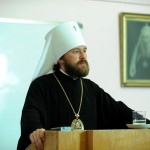by Metropolitan Hilarion Alfeyev
 Lecture delivered at the Kiev Theological Academy on September 20, 2002
Lecture delivered at the Kiev Theological Academy on September 20, 2002
Liturgical “Ceremony”
At this point I would like to review several aspects of the liturgical ceremony of the Orthodox Church, especially the peculiarities of hierarchical service. People sometimes say that Byzantine liturgical ceremony is outdated and needs to be simplified. The splendour of the Orthodox rite is contrasted with the “simplicity” and “accessibility” of Protestant services. Some consider the bishop’s rites to be too “pompous”, and some bishops only serve the so-called “priest’s service”, believing thereby that they thus demonstrate their humility urbi et orbi. One bishop told me that the presence of subdeacons at services distracted him from prayer and that the hierarchical ordo created a “barrier” between the praying faithful and the living God. He also mentioned that subdeacons, bishops’ staves and other items of the hierarchical service are but “tinsel” that must be discarded.
I do not agree with these statements. If services distract one from prayer, then why go to church in the first place? It would be better to stay home, close the door and pray to God in absolute solitude. If you are a bishop but serve the priest’s services, why did you need to be ordained to the episcopate? It would have been better for you to have remained a priest and to serve according to the order for presbyters. Of course, there are times when a bishop has to fulfill priestly functions and serve accordingly (for example, if he is the only clergyman in a particular church). Nevertheless, it seems to me artificial and unjustified when a bishop plays the role of a priest. A bishop’s humility should not be demonstrated in the services conducted according to his own capricious discretion and taste, but rather in faithful adherence to church tradition.
In the Russian emigre communities of the West there is a particular phenomenon unknown to those living in traditionally Orthodox countries: the affectation of poverty. Its roots go back to the times of the first, so-called “Paris”, emigration that lived in real poverty, when Orthodox parishes were housed in basements and bishops earned their living by sweeping streets. But times have changed and modern western bishops have long since ceased to be poor. Some of them, however, continue to affect poverty. When this affectation occurs in everyday matters it is possible to tolerate it, but when it is brought into liturgical practice it becomes unacceptable. A bishop’s lifestyle may be extremely simple: indeed, he may not only affect poverty, but really live in poverty and humility. But when officiating at services he should appear in all the splendour of his hierarchical dignity.
All forms of artificiality are foreign to Orthodox services, where there is not and should not be anything theatrical or showy. The hierarchical services, worked out in great detail, are not intended to entertain or distract the faithful from prayer but, on the contrary, draw them into the theourgic mystery of the heavenly Eucharist. All aspects of the divine services are symbolic and iconic: not only the iconostasis and church singing, but also the very orders of the services and their so-called ceremony. When subdeacons, deacons, and priests leave the sanctuary one after another holding candles, the bishop’s staff, dikiri, trikiri and ripidai, the bishop reads the prayer
“O Master, Lord our God, who hast established in the heavens the ranks and hosts of angels and archangels to serve Thy glory, do Thou make our entry an entry with the holy angels who serve and glorify with us Thy goodness”.
This entire solemn procession is an icon, a symbolic depiction of the majestic, intense, and reverent procession of angels accompanying the King of glory in Heaven. The same can be said of the Great Entrance, during which
“The King of kings and the Lord of lords comes to be slain and give Himself as food for the faithful, preceded by the angelic hosts with all authority and power, the many-eyed cherubim and the six-winged seraphim”.
It is these “angelic hosts” that are symbolized by the subdeacons, deacons and priests entering the altar to offer the bloodless sacrifice.
If all of this is simply “tinsel” that should be discarded, then why not remove icons, other sacred images and liturgical vessels as well, leaving only bare walls and a minimum of objects necessary for prayer? This is exactly what certain Protestant congregations have done, and now they are getting by quite well without icons and “ceremonies”. Everything is simple in their churches, just as in the early Church. But in simplifying the ceremonies and removing sacred images and symbolism from the Liturgy, have they really come closer to the Tradition of the Undivided Church, or have they gone further away from it?
I would like to add that the hierarchical service itself is an irreplaceable liturgical school for those involved in it, notably the subdeacons. Before each service they must carefully iron the bishop’s vestments and prepare all necessary liturgical items. Each of these actions is part of one larger sacred act, a kind of proskomedia for the subdeacons, whose behaviour during the service will, to a great extent, determine its overall atmosphere and the impression that it leaves on the congregation. Subdeacons are by no means the bishop’s servants, but servants of the Almighty, a fact that they themselves, the bishop, clergy and lay people must remember. There is no place for a servile attitude toward bishops as “bosses”. Instead, subdeacons should be taught above all a reverent attitude toward God, the Church and the sanctuary. The bishop should not be a demanding and captious commander to his subdeacons, but a father and teacher who helps them by his own example, character and concelebration to penetrate the mystical depths of the Liturgy and partake of the mysteries of the Kingdom of God.
